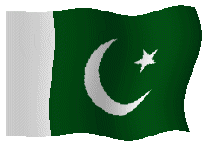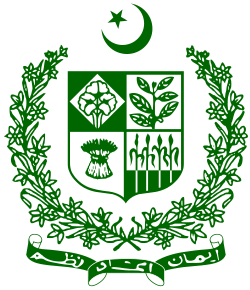 |
||||||
|---|---|---|---|---|---|---|
| ||||||
| |
|---|
| |
| |
| |
| |
| |
| |
| |
| |
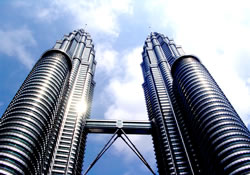 |
|---|
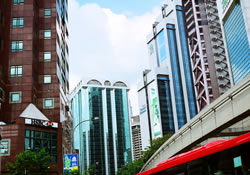 |
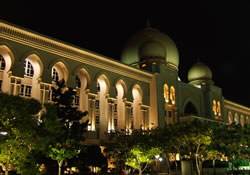 |
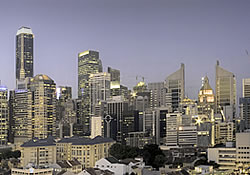 |
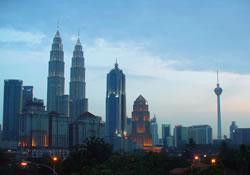 |
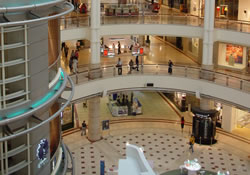 |
About Malaysia
Malaysia is a federation that consists of thirteen states and three federal territories in Southeast Asia with a total landmass of 329,847 square kilometres (127,355 sq mi). The capital city is Kuala Lumpur, while Putrajaya is the seat of the federal government. The population stands at over 27 million. The country is separated into two regions—Peninsular Malaysia and Malaysian Borneo—by the South China Sea. Malaysia borders Thailand, Indonesia, Singapore, Brunei and the Philippines. The country is located near the equator and experiences a tropical climate. Malaysia's head of state is the Yang di-Pertuan Agong and the government is headed by a Prime Minister. The government is closely modeled after the Westminster parliamentary system. Malays form the majority of the population of Malaysia. There are sizable Chinese and Indian communities as well. The Malay language is the official language. Though the Islamic religion is government funded the country is secular according to the constitution set following independence. Malaysia is a founding member of the Association of Southeast Asian Nations and participates in many international organisations such as the United Nations. As a former British colony, it is also a member of the Commonwealth of Nations. It is also a member of the Developing 8 Countries. GeographyThe two distinct parts of Malaysia, separated from each other by the South China Sea, share a largely similar landscape in that both West and East Malaysia feature coastal plains rising to often densely forested hills and mountains, the highest of which is Mount Kinabalu at 4,095.2 metres (13,435.7 ft) on the island of Borneo. The local climate is equatorial and characterised by the annual southwest (April to October) and northeast (October to February) monsoons. Kota Kinabalu, capital of East Malaysian state of Sabah is located 1600 km (1000 miles) east across the South China Sea from Kuala Lumpur Tanjung Piai, located in the southern state of Johor, is the southernmost tip of continental Asia. The Strait of Malacca, lying between Sumatra and peninsular Malaysia, is arguably the most important shipping lane in the world. Putrajaya is the newly created administrative capital for the federal government of Malaysia, aimed in part to ease growing congestion within Malaysia's capital city, Kuala Lumpur. Kuala Lumpur remains the seat of parliament, as well as the commercial and financial capital of the country. Other major cities include George Town, Ipoh, Johor Bahru, Kuching, Kota Kinabalu, Miri, Alor Star, Malacca Town, and Petaling Jaya. InfrastructureMalaysia has extensive roads that connect all major cities and towns on the western coast of peninsular Malaysia. As of 2006, the total length of the Malaysian expressway network is 1471.6 kilometres (914.4 miles). The network connects all major cities and conurbations such as Klang Valley, Johor Bahru and Penang to each other. The major motorway (E1 and E2, the E1 is the section North of KL while the E2 is the Southern section), spans from the northern and the southern tips of peninsular Malaysia at Bukit Kayu Hitam and Johor Bahru respectively. It is a part of the Asian Highway Network, which also connects into Thailand and Singapore. Roads in the East Malaysia and the eastern coast of peninsular Malaysia are still relatively undeveloped. Those are highly curved roads passing through mountainous regions and many are still unsealed, gravel roads. This has resulted in the continued use of rivers and the necessary use of airplanes as the main or alternative mode of transportation for the interior residents. Train service in West Malaysia is operated by the Keretapi Tanah Melayu (Malayan Railways) and has extensive railways that connect all major cities and towns on the peninsular, including Singapore. There is also a short railway in Sabah operated by Sabah State Railway that mainly carries freight. There are seaports throughout the country. The major ports are Port Klang and Port of Tanjung Pelepas in Johor. Other important ports can be found in Tanjung Kidurong, Kota Kinabalu, Kuching, Kuantan, Pasir Gudang, Penang, Miri, Sandakan and Tawau. Airports are also found throughout the country. Kuala Lumpur International Airport (KLIA) is the main airport of the country. Other important airports include Kota Kinabalu International Airport, Penang International Airport, Kuching International Airport, Langkawi International Airport, and Senai International Airport. There are also airports in smaller towns, as well as small domestic airstrips in rural Sabah and Sarawak. There are daily flight services between West and East Malaysia, which is the only convenient option for passengers travelling between the two parts of the country. Malaysia is the home of the first low-cost carrier in the region, AirAsia. It has Kuala Lumpur as its hub and maintains flights to Southeast Asia and China as well. In Kuala Lumpur, it operates out of the Low Cost Carrier Terminal (LCCT) in KLIA. |
|---|
 |
|||||||||||||||||||||||||||||||||||||
|---|---|---|---|---|---|---|---|---|---|---|---|---|---|---|---|---|---|---|---|---|---|---|---|---|---|---|---|---|---|---|---|---|---|---|---|---|---|
|
|||||||||||||||||||||||||||||||||||||

